Not most prominently the constellation of the southern sky, between Sagittarius and the south celestial pole. Not visible here. The brightest star of the constellation α Pavona is usually referred to by the English name "Peacock".
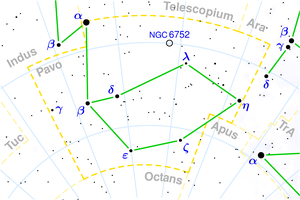
Peacock (α Pavi) - The brightest star of the constellation has an apparent magnitude of 1.9. In reality, it consists of two close components separated by 250 light-years. The star serves mainly as a reference point in a relatively poor area of stars. In a telescope, we can reveal two companions with magnitudes of 9 and 10.3. Peacock is a star of spectral class B2 with a diameter 2.5 times larger than the Sun. It shines 1000 times brighter than our Sun from a distance of 183 light-years.
ξ Pav - A tight binary star composed of unequally bright stars. It consists of a red giant with a brightness of 4.4 mag and a companion with a brightness of 8 mag. Both components are located 420 light-years away. When observed with a small telescope, it may be difficult to distinguish the fainter star due to the overpowering brightness of the brighter component.
κ Pav - Short-period variable Cepheids belonging to the subtype known as W Virginis stars from the old population II. Its brightness ranges from 3.9mag to 4.8mag with a period of 9 days and 2 hours. This yellow-white supergiant is located 540 light-years away.
NGC 6752
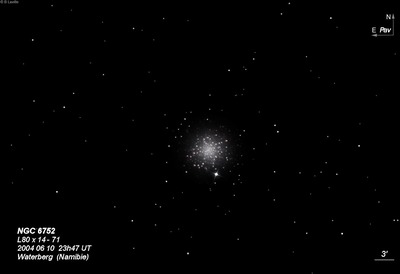
James Dunlop discovered NGC 6752 = D 295 = h3778 on 28 Jul 1826 at Parramatta Observatory (near Sydney) with his homemade 9-inch f/12 reflector. His full description reads: "a pretty large and very bright nebula, 5' or 6' diameter, irregular round figure, easily resolved into a cluster of small stars, exceedingly compressed at the centre. The bright part at the center is occasioned by a group of stars of some considerable magnitude when compared with those of the nebula. I am inclined to think that these may be two clusters in the same line; the bright part is a little south of the centre of the large nebula." He recorded the cluster on 5 times.
JH also made multiple observations. On sweep 480 (7 Aug 1834), he recorded "globular cluster; B; rich; psmbM; 7'. The stars are of 2 magnitudes, the larger 11m, run out in lines like crooked radii. The smaller, 16m, are massed together in and round the middle."
200/250mm - 8" (7/13/91 - Southern Baja): very bright, fairly large, 10' total diameter with a 2' brighter core that increased to very bright nucleus. The large halo was very mottled and partially resolved although viewed at only 6 degrees elevation as the brightest stars are mag 11. 15-20 stars mag 11-12 were visible around the edges of the core and within the halo in curved strings. Mag 7.7 SAO 254482 (h5085 = 7.7/9.2 at 2.8") is embedded in the SW portion of the halo 4.3' from the center. Ranks second in terms of brightest individual stars and appears very rich.
300/350mm - 12" (6/29/02 - Bargo, Australia): this naked-eye cluster ranks second in terms of brightest members (mag 11.5). The 4' core has several dozen mag 12-13 stars, many arranged in streaming curves and chains layered over a dense central glow. The halo is large but irregular with knots of mag 11-12 stars over a diffuse background. The brighter members, particularly in the outer halo give the visual appearance of a globular embedded in a larger, open cluster!
400/500mm - 18" (7/10/02 - Magellan Observatory, Australia): NGC 6752 is one of the top globular clusters (4th brightest in integrated magnitude and 2nd in terms of brightest members) and was spectacular from Magellan Observatory. At 128x, this naked-eye cluster seemed fully resolved with an uncountable number of stars densely packed over a large region. Streamers in the halo greatly increased the diameter to roughly 20'. The central region was well-compressed to a very bright core! There was a strong 3-dimensional effect as the core was covered with scores of fairly bright stars seemingly superimposed over a rich mat of fainter stars and all set over a background glow. The nucleus was small and very bright. Many 11-12th magnitude stars in the halo formed complete loops and long chains. A mag 7.7 double star is superimposed on the SW edge of the halo (h5085 = 7.7/9.2 at 2.8"). This was one of my favorite objects from Australia!
Notes by Steve Gottlieb
NGC 6744
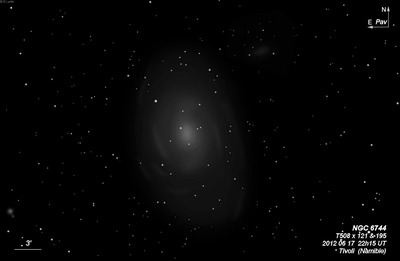
James Dunlop discovered NGC 6744 = D 262 = h3776 on 30 Jun 1826 with his 9" reflector from Parramatta (20 km W of Sydney). He described "a pretty large very faint nebula, about 5' or 6' diameter, slightly bright towards the centre; a minute star is north of the nebula, and two stars of the 7th mag preceding." His position is 1 min 45 sec of time too far west (12' error). On 20 Jun 1835, John Herschel recorded "pB; R; at first vg, then svmbM; total diam 2', but that of the bright part = 15"." His position is accurate.
400/500mm - 20" (6/29/02 - Bargo, Australia): bright, large, elongated 3:2 SSW-NNE, ~9'x6'. A bright, oval core or bar is surrounded by a moderately low surface halo with an impression of "motion" or arcs embedded within the outer glow.
600/800mm - 30" (11/6/10 - Coonabarabran, 264x): I primarily scanned NGC 6744 looking for very small HII regions. The offsets stated here are relative to a very small bright nucleus, which was sharply concentrated within the core. A non-stellar knot was noted 2.5' NW of the nucleus. A second knot was seen 2.9' ESE of the nucleus and a third was just 1.6' NE of center. Roughly a dozen "stars" are superimposed on the galaxy and some of the fainter ones may be stellar HII knots. Spiral structure was too subtle to see any definite arms. IC 4823 (a double system) lies 18' SE.
Notes by Steve Gottlieb
IC 5052
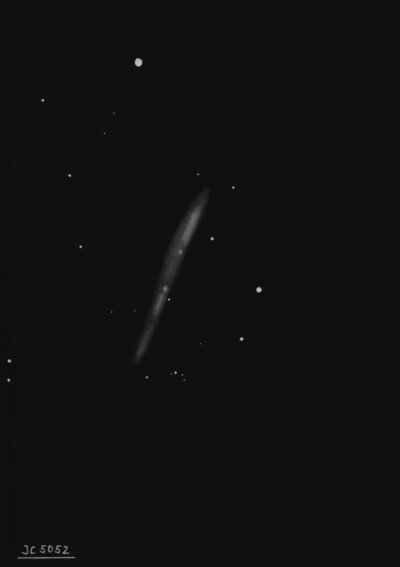
DeLisle Stewart discovered IC 5052 = DS 692 on a plate taken on 23 Aug 1900 at Harvard's Arequipa station in Peru. He noted "F, L, eE at 140°, 4' long."
400/500mm - 18" (7/9/02 - Magellan Observatory, Australia): at 128x this galaxy appears as a beautiful, narrow edge-on streak with little or no central concentration. It is elongated ~10:1 NW-SE, ~5'x0.5', with a slightly bulging core and a gradual tapering towards the tips. A mag 10 star lies 5' N. Located 30' SE of mag 5.4 Sigma Pavonis. NGC 6943 lies 43' NW.
600/800mm - 30" (10/14/15 - OzSky): at 394x; gorgeous edge-on galaxy! Fairly bright, extremely large, very thin ~10:1 NW-SE, ~5.5'x0.6', slightly brighter core, bulges very slightly at the center or offset to the northwest side, tapers more thinly on the southeast end. A mag 16.3 star is at the north edge of the northwest extension, a mag 16.5 star is off the south edge at this end and a mag 17.5 star is very close to the tip.
Notes by Steve Gottlieb
IC 4662
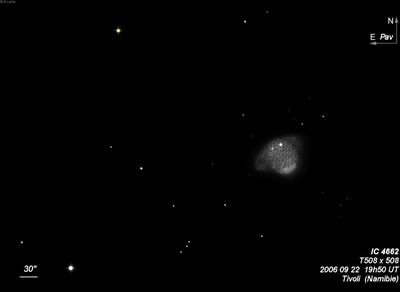
According to the article "Star formation in the irregular galaxy IC 4662" (A&A, 1990, 234, 99) the elongated knot on the northeast side contains two giant HII regions comparable to the 30 Doradus complex! IC 4662 is identical to He 2-269 (PK 328-17.1), which Karl Henize included in a 1967 list of planetary nebulae discovered through H-alpha emission on objective prism plates. In a 1970 paper, Pastoriza gave the classification as a nearby dwarf emission line galaxy with a radial velocity of ~400 km/sec (less than 10 million l.y.).
Robert Innes discovered IC 4662 visually in 1901 with the 7-inch Merz refractor at the Cape of Good Hope. He noted "a faint oval nebula 1' in diameter, N.p. Eta Pavonis. Found with the 7-inch." Based on plates taken at Arequipa, DeLisle Stewart noted "F, S, irr, 2 st. inv." Stewart referenced Innes' discovery announcement in MN 62, 470.
400/500mm - 18" (7/8/02 - Magellan Observatory, Australia): at 171x, this irregular galaxy has a disrupted appearance or perhaps is interacting with a companion. The structure is difficult to separate but the brighter component on the northeast side is moderately bright, small, elongated WNW-ESE. Attached on the south side is a larger, but fainter extension oriented nearly perpendicular to the brighter component. A faint star is at the edge. IC 4662 is located just 10' NE of mag 3.7 Eta Pavonis and the bright star interferes with viewing if left in the field.
Notes by Steve Gottlieb
NGC 6769
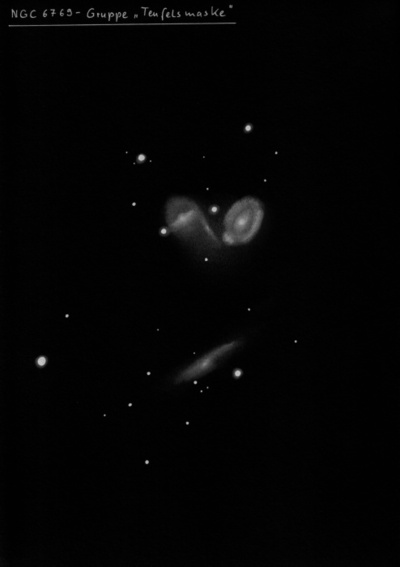
The trio is listed as an isolated southern triplet (KTS 59) by Karachentsev. The group is situated just over a degree southeast of the showpiece gc NGC 6752 and is part of the Pavo-Indus Supercluster.
John Herschel discovered NGC 6769 = h3783, along with NGC 6770 and 6771, on 11 Aug 1836 and recorded "vF; R; lbM; 20". The first of 3." His RA is 1.0 minute too small. DeLisle Stewart provided an accurate RA (given in the IC 2 Notes), based on plates at Harvard's Arequipa Station in Peru. While observing NGC 6769 on 3 Aug 1883 with the 48" Melbourne telescope, Joseph Turner discovered IC 4836, situated about 24' NW.
400/500mm - 18" (7/9/02 - Magellan Observatory, Australia): this is the brightest member and first of four in an interesting galaxy group! It appeared moderately bright and large, slightly elongated NW-SE, 1.5'x1.2'. In a close trio with NGC 6770 1.9' E and NGC 6771 3.5' SE with a 4th galaxy, IC 4842, 11' SE. On the DSS image this galaxy is clearly distorted from interacting with NGC 6770 with streamers, plumes, loops and H II regions in the outer arm. IC 4842 appeared appears fairly faint, moderately large, elongated 3:2 SSW-NNE, 1.2'x0.8', slightly brighter core. IC 4845 lies 16' NE.
600/800mm - 25" (10/17/17 - OzSky): at 244x; brightest member in a group and interacting with NGC 6770. It appeared bright, fairly large, elongated 4:3 WNW-ESE, 1.6'x1.2'. Sharply concentrated with a very bright elongated core. A mag 12.2 star is at the east edge, 0.9' ENE of center. NGC 6771 lies 3.5' SE, forming a striking triplet in a rich star field with IC 4842 11.5' SE and IC 4845 16' NE.
Notes by Steve Gottlieb
NGC 6872
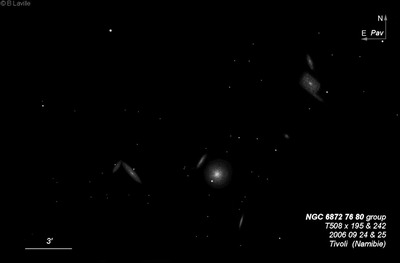
In 1979A&A, 79, 22, the abstract for "NGC 6872 - A remarkable barred spiral" states, "The extent of the arms is probably greater than in any other spiral known; it is concluded that NGC 6872 is a conventional barred spiral in which severe tidal interaction took place."
John Herschel discovered NGC 6872 = h3816 on 27 Jun 1835 and recorded "F; R; glbM; 30"; has a vS * preceding. first of 4 [with NGC 6876, 6877 and 6880]." On a second observation he called it "F; E; 40" l; has a * 9m 10.5 seconds preceding."
Joseph Turner discovered nearby IC 4970 on 27 August 1881during an observation of NGC 6872 with the Great Melbourne Telescope.
400/500mm - 18" (7/10/02 - Magellan Observatory, Australia): second brightest in the Pavo-I Group with brightest member NGC 6876. Moderately bright, fairly small, elongated 2:1 SW-NE in the direction of a mag 10.4 star 1.1' WSW of center, ~1.2'x0.6', broad concentration with a brighter core. Interacting with IC 4970 at 1.1' N just outside the halo while fainter PGC 64439 lies 4.0' SE. Other members of the group include NGC 6876, NGC 6877, NGC 6880. IC 4970 appeared faint, very small, slightly elongated, 20"x15". Images reveal a distorted bridge and plumes due to interaction with NGC 6872. PGC 64439, nearly at the midpoint of NGC 6872 and NGC 6876, appeared very faint and small, round, 0.3' diameter, low surface brightness.
18" (7/8/02 - Magellan Observatory, Australia): moderately bright, elongated 2:1 SW-NE towards a mag 10.5 star off the SW edge, 1.2'x0.5'. Fairly well concentrated with a small bright core.
600/800mm - 30" (10/13/15 - OzSky): NGC 6872 is a remarkably stretched spiral with extremely distended arms spanning roughly 750,000 light years. At 303x it appeared very bright, fairly large, elongated 5:3 SW-NE, 1.2'x0.7', sharply concentrated with a bright core encasing an extremely bright nucleus. A mag 10.4 star is off the west side of the halo, just 1.1' WSW of center. The initial portions of the spiral arms are visible as thin, very low surface brightness wings, extending ~1' southwest on the south side and northeast on the north side. The tidal extensions were not seen. A mag 13 star lies 2.4' ENE. IC 4970, an interacting companion 1.1' N of center, appeared fairly faint to moderately bright, fairly small, slightly elongated N-S, 0.4'x0.25', contains a very small bright nucleus.
Notes by Steve Gottlieb
NGC 6684

NGC 6684A lies 30' NE. It was observed on 14 Oct 2015 at 303x with the 3RF 30" near Crookwell. At 303x it appeared very large, low surface brightness glow, irregularly round, ~2' in diameter. Exhibits a very weak central brightening and there was no defined edge to the halo. A pair of mag 13-14 stars is at the southwest edge. Located 30' NE of NGC 6684 and 28' NE of mag 5.7 Theta Pavonis. Nestled in a group of stars, including a mag 9.7 star 2.7' NW, a mag 8.5 star 7.7' SE and a number of mag 13-14 stars.
John Herschel discovered NGC 6684 = h3757 on 8 Jun 1836 and recorded "vB; R; first vg, then psmbM; 90"; a * 6-7m, 7' sp." The RNGC misclassifies this galaxy as a globular cluster.
400/500mm - 18" (7/9/02 - Magellan Observatory, Australia): at 171x this galaxy appeared fairly bright and large, slightly elongated SW-NE, 2.0'x1.6'. Sharply concentrated with a strikingly bright core and a large, slightly oval halo. The core brightens evenly to a stellar nucleus with direct vision. A mag 11 star is off the south side, 2.5' from center. Located 6' SSE of mag 5.7 Theta Pavonis! Member of the NGC 6744 group.
Notes by Steve Gottlieb
NGC 6810
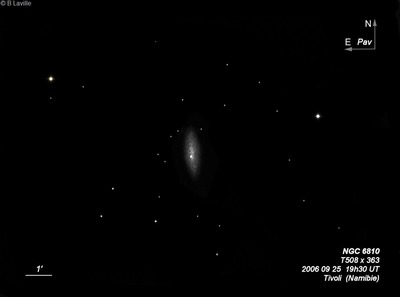
John Herschel discovered NGC 6810 = h3797 on 10 Jul 1834 and recorded "B; mE, in position 169.2°; psbM; 90"." His position is accurate. On the next sweep he called this object "R; vgbM; 30" haze thickening rapidly." The second (poorer) description was given in the GC and NGC, and DeLisle Stewart reported (based on plates taken at Harvard's Arequipa Station), "not round, but cF, S, eE 179°, stell ncl."
400/500mm - 18" (7/9/02 - Magellan Observatory, Australia): at 128x appears moderately bright and large, elongated 3:1 N-S, 2.0'x0.7'. The bright core is concentrated to a stellar nucleus with direct vision. On the DSS image, this Seyfert galaxy shows an absorption lane along the eastern side but this was not seen visually.
Notes by Steve Gottlieb
NGC 7021
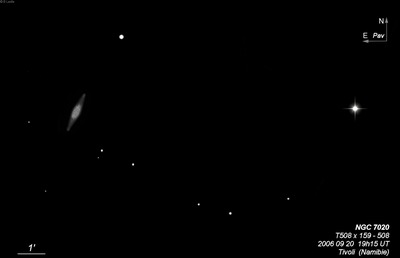
600/800mm - 30" (10/10/15 - OzSky): at 394x; bright, fairly large, elongated 3:1 NNW-SSE, ~2.5'x1.2', sharply concentrated with a very bright elongated core that increases to the center and a very low surface brightness halo. Located 8' E of mag 6.9 HD 201020. Brightest in a small group with IC 5092 41' SE and IC 5096 49' NE. Structurally, NGC 7020 is one of the most prominent outer-ringed (detached) galaxies in the sky.
Notes by Steve Gottlieb
IC 4687
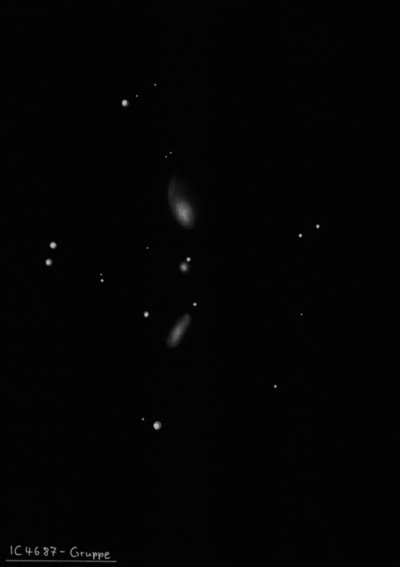
On the HST image of the trio, IC 4687 has a disrupted, chaotic appearance of gas and dust with a tidal plume to the north. It appears merged with IC 4686 on its south side.
Royal Frost discovered IC 4687 = F. 1153 on a plate taken 1 Aug 1904 at Harvard's Arequipa Station. He noted "bM, magn 14". The same description was noted for nearby IC 4686 and 4689.
600/800mm - 25" (10/15/17 - OzSky): IC 4687 is the largest and northernmost of an excellent, close interacting triplet (AM 1809-574 = KTS 57). At 397x it appeared fairly faint, fairly small, elongated 3:2 ~SW-NE, ~0.6'x0.4', well concentrated with a very small bright core. IC 4686 is at the south edge, just 27" between centers and IC 4689 is 1.4' S! Situated in a rich star field 14' NE of an excellent close double HJ 5029 = 8.3/8.6 at 1.8".
Notes by Steve Gottlieb